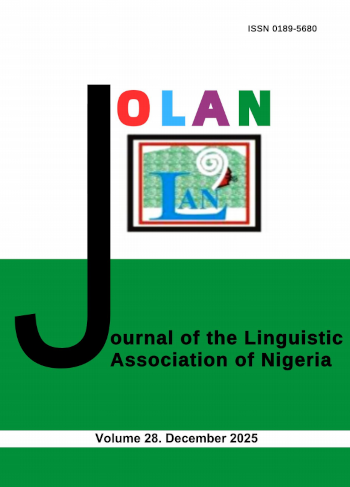Resolving Vowel Elision Complexities in Yoruba with Harmonic Constraints
Keywords:
Vowel hiatus, Vowel elision, AGREE[F], *NO HIATUS, ANCHOR LAbstract
Resolving vowel hiatus has generated different analyses using the available theoretical approaches. More to the challenge is the question of which vowel actually elides. The case of the elided vowel in a language like Yoruba continues to generate different form of analyses with none fully accounting for the process; among these include Casali (2007) MAXLEX approach and Orie and Pulleyblank (1998, 2000) Prosodic Minimality approach. However, more is involved to which vowel is elided than these. This paper aims to provide evidence on how vowel qualities such as vowel height and Advance Tongue Root contribute to the elided vowel. It also provides analysis to existing exemptions found in Optimality formalisms for Yoruba vowel elision. The paper is developed following the Constraints Based analysis. It draws from faithfulness and markedness (Prince and Smolensky, 1993; McCarthy, 1995) and harmonic constraints (Bakovic, 2000) to provide analysis of vowel elision process of hiatus environment resulting in disyllables. Findings show that ((C)VCV) Yoruba words resulting from vowel elision is subject to harmonic constraints in Yoruba, together with faithfulness and markedness constraints. The paper suggested that in a native speaker’s mind, the constraints are ranked proportionately for the required output; it could higher rank or lower rank conflicting constraints and at the same time allow some of these conflicting constraints violated. As such covert rankings are allowed to take place before output candidate evaluations.
References
Adetugbọ, A. 1967. The Yoruba Language in Western Nigeria. Its Major Dialect Areas. PhD Thesis. Dept. of Linguistics. Columbia University.
Adetugbọ, A (1973) "The Yoruba Language in Yoruba History". In Biobaku, S O. (ed.): Sources of Yoruba History. Ibadan.
Awobuluyi, O. 1998 ÀwonÈka-èdè Yorùbá' (Yorùbá Dialects). Paper presented at the meeting of the Yorùbá Studies Association of Nigeria. November 1998, Ibadan Bendor S.J.
Bamgbose, A. 1967. Vowel Harmony in Yoruba. Journal of African Languages 6, 268-273.
Bakovic, E 2000. Harmony, Dominance and Control. Ph.D. Thesis. Dept. of Linguistics. Rutgers University.
Bakovic, E. 2007. Hiatus resolution and incomplete identity. In Fernando Martínez-Gil & Sonia Colina (eds.) Optimality theoretic studies in Spanish phonology, 62–73. Amsterdam & Philadelphia: John Benjamins.
Casali, R. F. 1997. Vowel elision in hiatus context: Which vowel goes? Language. (73). 493-533
Casali, R. F. 1998. Resolving hiatus. New York and London. Garland.
Casali, R. F. 2011. Hiatus Resolution. The Blackwell Companion to Phonology. van Oostendorp, Marc, Colin J. Ewen, Elizabeth Hume and Keren Rice (eds). Blackwell
Chomsky, Noam and Lasnik, Howard (1977) Filters and Control. Linguistic Inquiry 8, 425-504
Délànò, I.O. 1958. ̣̀ Atúmò Èdè Yorùbá - A Short Yorùbá Grammar and Dictionary. London: Oxford University Press.
McCarthy, J. & Alan, P. 1993a. Prosodic Morphology: Constraint interaction and satisfaction. Ms. University of Massachusetts and Rutgers University.
McCarthy, J. and Alan, P. 1995. Faithfulness and reduplicative identity. In Jill N. Beckman, Laura Walsh Dickey, and Suzanne Urbanczyk, eds., Papers in Optimality Theory, University of Massachusetts Occasional Papers 18, 249–384.
Orie, O. and Pulleyblank, D. 1998. Vowel elision is not always onset-driven. Tulane University & University of British Columbia.
Orie, O. &Pulleyblank, D. 2002. Vowel Elision: Minimality Effects. Natural Language and Linguistic Theory. Vol. 20, pp. 101-156. Springer
Oyebade, F. 1998. A course in phonology. Ijebu-Ode: Shebotimo.
Oyelaran, O. 1976. “Linguistic Speculations on Yoruba History” In Oyelaran, O. (ed) Seminar Series 1. pp.624-651. Department of African Languages and Litratures, Ife
Prince, A. and Smolensky, P. 1993. Optimality Theory: constraint interaction and satisfaction. Ms., Rutgers University and the University of Colorado at Boulder.
Pulleyblank, D. 1986. Underspecification and low vowel harmony in Okpe. Studies in African Linguistics (17) . 119–153.
Pulleyblank, D. 1988. Vowel deletion in Yoruba. Journal of African Languages and Linguistics (10) . 117–136.
Pulleyblank, D. and Archangeli, D. 1989. Yoruba vowel harmony. Linguistic Inquiry, Vol. 20, No. 2, pp. 173-217. MIT Press
Rosenthall, S. 1994. Vowel/glide alternation in a theory of constraint interaction. Ph.D. thesis. Dept. of Linguistics. University of Massachusetts, Amherst
Sedil, A. 2000. Yoruba Vowel Elision and Compounding. University of Pennsylvania
Senturia, M. B. 1998. A prosodic theory of hiatus resolution. Ph.D. thesis. Dept. of Linguistics. University of California, San Diego.
Williamson, K. and Roger, B. 2000. Niger-Congo. In Heine, B. and Nurse, D (eds) African Languages: An Introduction. Cambridge: Cambridge University Press. pp11-42.














